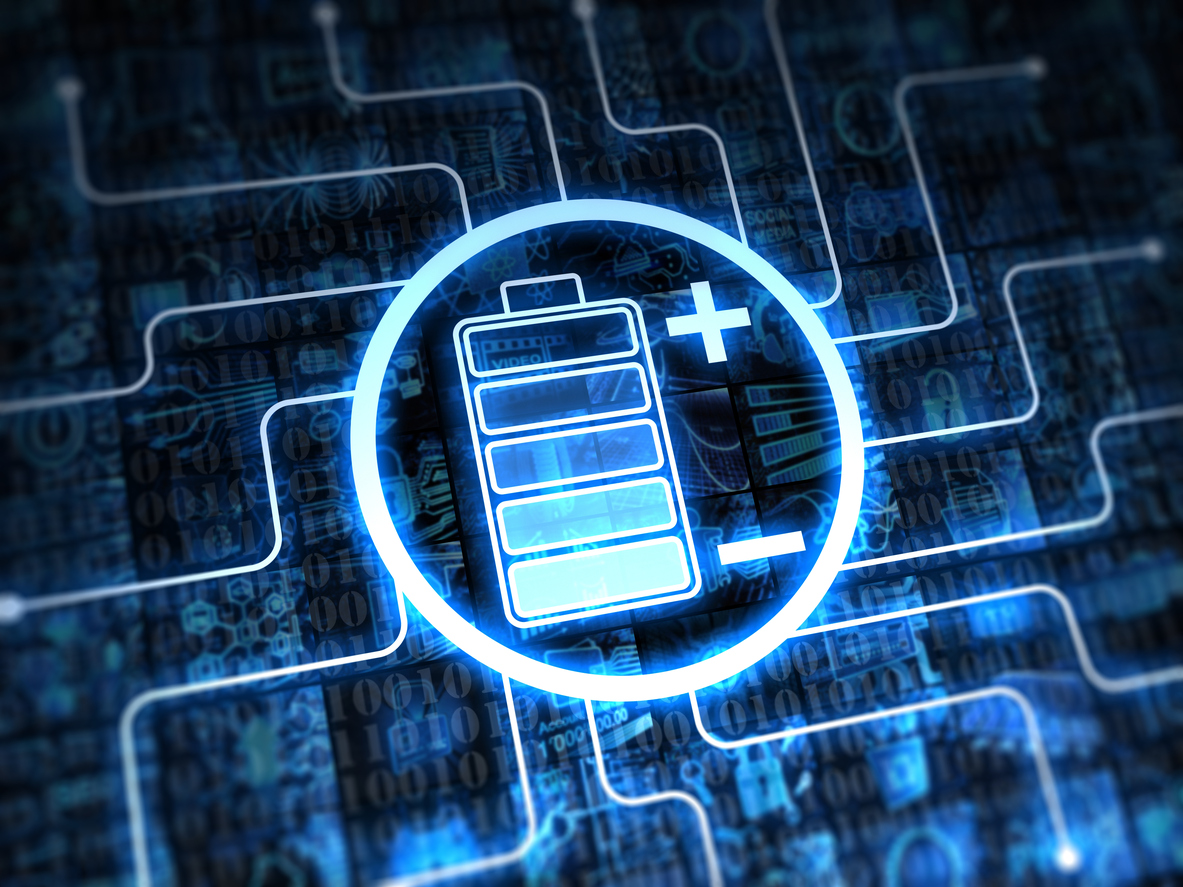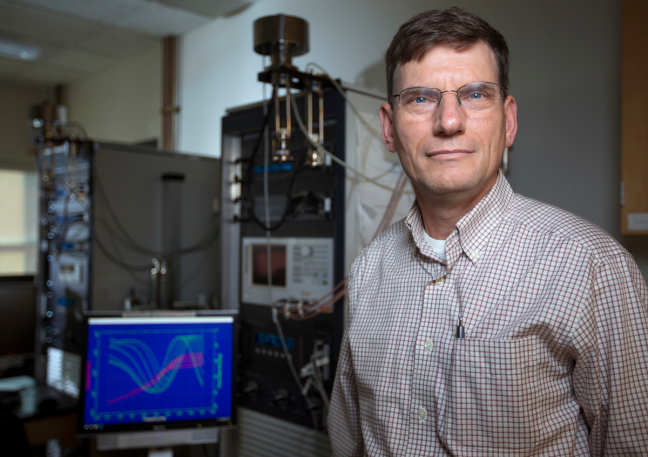The electric vehicle market continues to build momentum every year, with consumers around the world growing more interested. But in order for EVs to pave the way for the future of transportation, more efficient, longer-lasting batteries will need to be developed.
 The consumer demand for seamless, integrated technology is on the rise, and with it grows the Internet of Things, which is expected to grow to a multitrillion-dollar market by 2020. But in order to develop a fully integrated electronic network, flexible, lightweight, rechargeable power sources will be required.
The consumer demand for seamless, integrated technology is on the rise, and with it grows the Internet of Things, which is expected to grow to a multitrillion-dollar market by 2020. But in order to develop a fully integrated electronic network, flexible, lightweight, rechargeable power sources will be required.
A team of researchers from Ulsan National Institute of Science and Technology is looking to address that issue, developing inkjet-printed batteries that can be modified to fit devices of any shape and size. The team reports that the newly developed inks can be printed onto paper to create a new class of printed supercapacitors.
(READ: Rise of Cyber Attacks: Security in the Digital Age)
This from Ulsan National Institute of Science and Technology:
The process involves using a conventional inkjet printer to print a preparatory coating—a ‘wood cellulose-based nanomat’—onto a normal piece of A4 paper. Next, an ink of activated carbon and single-walled nanotubes is printed onto the nanomat, followed by an ink made of silver nanowires in water. These two inks form the electrodes. Finally, an electrolyte ink—formed of an ionic liquid mixed with a polymer that changes its properties when exposed to ultraviolet light—is printed on top of the electrodes. The inks are exposed at various stages to ultraviolet irradiation and finally the whole assembly is sealed onto the piece of paper with an adhesive film.
 A team of scientists from Oak Ridge National Laboratory is using the precision of an electron beam to instantly adhere cathode coatings for lithium-ion batteries. This new development, as reported in the Journal of The Electrochemical Society, could lead to a leap in efficiency that saves energy, reduces production cost, and eliminates the use of toxic solvents.
A team of scientists from Oak Ridge National Laboratory is using the precision of an electron beam to instantly adhere cathode coatings for lithium-ion batteries. This new development, as reported in the Journal of The Electrochemical Society, could lead to a leap in efficiency that saves energy, reduces production cost, and eliminates the use of toxic solvents.
This from ORNL:
The technique uses an electron beam to cure coating material as it rolls down the production line, creating instantaneous cross-links between molecules that bind the coating to a foil substrate, without the need for solvents, in less than a second.
“Typical curing processes can require drying machinery the length of a football field and expensive equipment for solvent recovery,” says David Wood, co-author of the study. “This approach presents a promising avenue for fast, energy-efficient manufacturing of high-performance, low-cost lithium-ion batteries.”
Read the full paper, “Electron Beam Curing of Composite Positive Electrode for Li-Ion Battery.”
 One of the keys to developing a successful electric vehicle relies on energy storage technology. For an EV to be successful in the marketplace, it must be able to travel longer distances (i.e. over 300 miles on a single charge).
One of the keys to developing a successful electric vehicle relies on energy storage technology. For an EV to be successful in the marketplace, it must be able to travel longer distances (i.e. over 300 miles on a single charge).
A team of researchers from Georgia Institute of Technology, including ECS fellow Meilin Liu, has recently created a nanofiber that they believe could enable the next generation of rechargeable batteries, and with it, EVs. The recently published research describes the team’s development of double perovskite nanofibers that can be used as highly efficient catalysts in fast oxygen evolution reactions. Improvements in this key process could open new possibilities for metal-air batteries.
“Metal-air batteries, such as those that could power electric vehicles in the future, are able to store a lot of energy in a much smaller space than current batteries,” Liu says. “The problem is that the batteries lack a cost-efficient catalyst to improve their efficiency. This new catalyst will improve that process.”
Batteries Get a Boost with Material Found in Sunscreen
Posted on February 20, 2017 by Amanda Staller
Source: iStock
Today’s electronics consumers all have one thing in common: a desire for smartphones and other portable devices to have longer battery lives. Researchers from the University College Cork are looking to deliver just that with a new development that extends the cycle life of the lithium-ion battery to near record-length by using a key ingredient found in sunscreen.
The method, developed by ECS member and vice chair of the Society’s Electronics and Photonics Division, Colm O’Dwyer, and past members David McNulty and Elaine Carroll, uses titanium dioxide, which is a naturally occurring material capable of absorbing ultraviolet light.
When titanium dioxide is made into a porous substance, it can be charged and discharged over 5,000 times – or 13.5 years – without a drop in capacity.
According to scientists at the University at Buffalo, a new glowing dye called BODIPY could be a central part of the liquid-based batteries that researchers are looking at to power our cars and homes.
BODIPY – or boron-dipyrromethene – is a fluorescent material that researchers believe could be an ideal material for stockpiling energy.
The new research shows that BODIPY-based batteries operate efficiently and display promising potential for longevity, functioning for more than 100 charge cycles.
“As the world becomes more reliant on alternative energy sources, one of the huge questions we have is, ‘How do we store energy?’ What happens when the sun goes down at night, or when the wind stops?” says lead researcher Timothy Cook, ECS member and assistant professor of chemistry at the University at Buffalo. “All these energy sources are intermittent, so we need batteries that can store enough energy to power the average house.”
 Twenty-sixteen marked the 25th anniversary of the commercialization of the lithium-ion battery. Since Sony’s move to commercialize the technology in 1991, the clunky electronics that were made possible by the development of the transistor have become sleek, portable devices that play an integral role in our daily lives – thanks in large part to the Li-ion battery.
Twenty-sixteen marked the 25th anniversary of the commercialization of the lithium-ion battery. Since Sony’s move to commercialize the technology in 1991, the clunky electronics that were made possible by the development of the transistor have become sleek, portable devices that play an integral role in our daily lives – thanks in large part to the Li-ion battery.
“There would be no electronic portable device revolution without the lithium-ion battery,” Robert Kostecki, past chair of ECS’s Battery Division and staff scientist at Lawrence Berkeley National Laboratory, tells ECS.
Impact of Li-ion technology
Without Li-ion batteries, we wouldn’t have smartphones, tablets, or laptops – more so, electric vehicles would have a slim chance of competing in the transportation sector and dreams of large-scale energy storage for a renewable grid may be dashed. Without the Li-ion, there would be no Tesla. There would be no Apple. The landscape of Silicon Valley as we know it today would be vastly different.
While the battery may have hit the marketplace in the early ‘90s, pioneers such as Stanley Whittingham, Michael Thackeray, John Goodenough, and others began pushing the technology in the ‘70s and ‘80s.
In its initial years, Li-ion battery technology boomed. As the field gained more interest from researchers after commercialization, developments started pouring in that doubled, or in some cases, tripled the amount of energy the battery was able to store. While progress continued over the years, the pace began to slow. Incremental advances at the fundamental level opened new paths for small, portable electronics, but have not answered demands for large-scale grid storage or an electric vehicle battery that will allow for a drive range of over 300 miles on a single charge.

ECS member Steve Martin receives a $2.5M grant to pursue research in glassy solids.
Image: Christopher Gannon
The world relies on battery power. The smartphone market alone – which is powered by lithium-ion batteries – is expected to reach 1.5B units in 2016. ECS member Steve Martin believes he may be able to take those batteries to the next level through efforts in glassy solids.
Martin, a professor at Iowa State University and associate of the U.S. Department of Energy’s Ames Laboratory, has been in the field of battery research for over 30 years. Throughout that time, his main focus of research has shifted to measuring the basic properties of glassy solids and trying to understand how their ions move and the thermal and chemical stability.
Martin believes that using glass solids as the electrolytes in batteries would make them safer and more powerful. This is an effort to diverge from traditional liquid-electrolyte batteries, which have experienced issues with safety and energy capacity.
To push this research, Martin recently received a three-year, $2.5M grant from the DOE.
“This is my dream-come-true project,” Martin says. “This is what I’ve been working on for 36 years.”
Lithium-ion battery safety has been a hot topic in the scientific community in light of instances of the Samsung Galaxy Note 7 bursting into flames. In order to address these concerns, scientists must first better understand exactly what is causing these safety concerns. In order to do that, a team from the University of Michigan is looking inside the batteries and filming growing dendrites – something the researchers cite as one of the major problems for next-gen lithium batteries.
The study focused primarily on lithium-metal batteries, which have the potential to store 10 times more energy that current lithium-ion batteries. However, researchers believe that issues with dendrites cannot be amended, the future of the Li-metal battery will not be as limitless as some believe.
“As researchers try to cram more and more energy in the same amount of space, morphology problems like dendrites become major challenges. While we don’t fully know why the Note 7s exploded, dendrites make bad things like that happen,” said Kevin Wood, postdoctoral researcher and ECS student member. “If we want high energy density batteries in the future and don’t want them to explode, we need to solve the dendrite problem.”
Advancing Lithium-air Batteries with Development of Novel Catalyst
Posted on September 15, 2016 by Amanda Staller Lithium-air batteries are viewed by many as a potential next-generation technology in energy storage. With the highest theoretical energy density of all battery devices, Li-air could revolutionize everything from electric vehicles to large-scale grid storage. However, the relatively young technology has a few barriers to overcome before it can be applied. A new study published in the Journal of The Electrochemical Society (JES) is taking a fundamental step forward in advancing Li-air through the development of mixed metal catalyst that could lead to more efficient electrode reactions in the battery.
Lithium-air batteries are viewed by many as a potential next-generation technology in energy storage. With the highest theoretical energy density of all battery devices, Li-air could revolutionize everything from electric vehicles to large-scale grid storage. However, the relatively young technology has a few barriers to overcome before it can be applied. A new study published in the Journal of The Electrochemical Society (JES) is taking a fundamental step forward in advancing Li-air through the development of mixed metal catalyst that could lead to more efficient electrode reactions in the battery.
The paper, entitled “In Situ Formed Layered-Layered Metal Oxide as Bifunctional Catalyst for Li-Air Batteries,” details a cathode catalyst composed of three transition metals (manganese, nickel, and cobalt), which can create the right oxidation state during the battery cycling to enable both the catalysis of the charge and the discharge reaction.
Future opportunities
According to K.M. Abraham, co-author of the paper, the manganese allows for the catalysis of the oxygen reduction reaction while the cobalt catalyzes the charge reaction of the battery.
“This offers opportunities for future research to develop similar materials to optimize the catalysis of the Li-air battery using one material that will combine the functions of these mixed metal oxides,” Abraham says.


